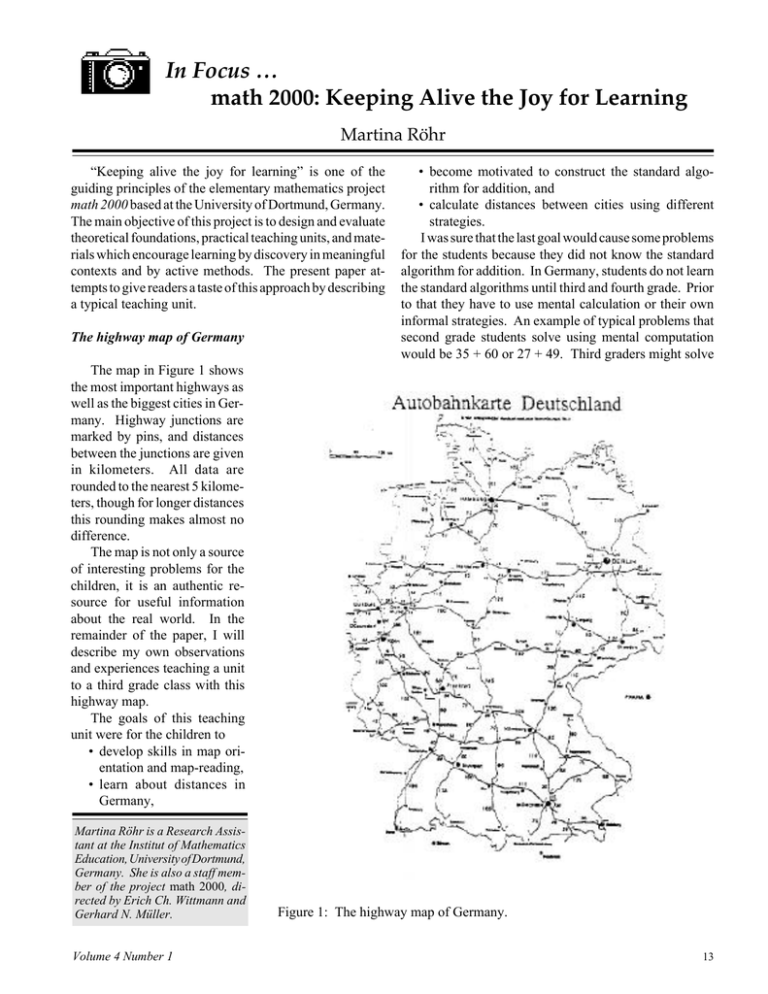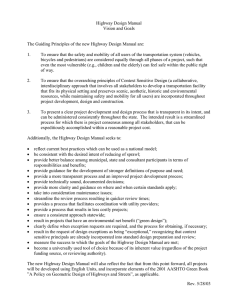In Focus … math 2000: Keeping Alive the Joy for Learning
advertisement

In Focus … math 2000: Keeping Alive the Joy for Learning Martina Röhr “Keeping alive the joy for learning” is one of the guiding principles of the elementary mathematics project math 2000 based at the University of Dortmund, Germany. The main objective of this project is to design and evaluate theoretical foundations, practical teaching units, and materials which encourage learning by discovery in meaningful contexts and by active methods. The present paper attempts to give readers a taste of this approach by describing a typical teaching unit. The highway map of Germany • become motivated to construct the standard algorithm for addition, and • calculate distances between cities using different strategies. I was sure that the last goal would cause some problems for the students because they did not know the standard algorithm for addition. In Germany, students do not learn the standard algorithms until third and fourth grade. Prior to that they have to use mental calculation or their own informal strategies. An example of typical problems that second grade students solve using mental computation would be 35 + 60 or 27 + 49. Third graders might solve The map in Figure 1 shows the most important highways as well as the biggest cities in Germany. Highway junctions are marked by pins, and distances between the junctions are given in kilometers. All data are rounded to the nearest 5 kilometers, though for longer distances this rounding makes almost no difference. The map is not only a source of interesting problems for the children, it is an authentic resource for useful information about the real world. In the remainder of the paper, I will describe my own observations and experiences teaching a unit to a third grade class with this highway map. The goals of this teaching unit were for the children to • develop skills in map orientation and map-reading, • learn about distances in Germany, Martina Röhr is a Research Assistant at the Institut of Mathematics Education, University of Dortmund, Germany. She is also a staff member of the project math 2000, directed by Erich Ch. Wittmann and Gerhard N. Müller. Volume 4 Number 1 Figure 1: The highway map of Germany. 13 problems such as 180 + 230 + 20 in this manner. Such tasks on the bottom of the page and supposed that the numbers generally have no more than three summands. could be kilometers. The other group members did not One of the purposes of this unit is for the children to believe that, but the girl was able to find reasons for her notice that there are real-life problems, such as determin- conjecture and so persuaded her group. She found a ing the distance between two cities, which are not easy to highway with the number 100 and compared the scale to solve with the skills they already have. They are encour- this part of the highway. Then she explained that the aged to try to find strategies for these long addition numbers would give the distances between two junctions problems. These strategies should motivate the students to of a highway. One boy tried to disprove this theory by learn the standard algorithm for addition from these prob- measuring, but he could not. lems . Another group was sure that the numbers were kilomeTeaching this unit involved three 45-minute lessons, ters; however, they did not see the importance of the one on each of three consecutive days. The first lesson junctions. They added numbers indiscriminately, got started with a short whole class discussion about maps of different results for the same distance, and discussed how Germany and how maps are useful in real life. The children this could be. related stories about vacation experiences with maps and During the following whole class discussion each how difficult it was for their parents to find the right way group talked about its discoveries. They explained the even with a map. Without giving them any further infor- meaning of the pins and numbers, and together we figured mation, I let them work in groups of four to familiarize out the distance from Dortmund to Aachen. Then I posed themselves with the map. I wanted them to find out what the task of figuring out the distance from Dortmund to they could do with the map and what information they Berlin. The students were directed to work in groups and could get from it. to find strategies for solving this problem. Each group took a different approach to this investigaDuring the group work, I saw very interesting stratetion and the children discussed many interesting things gies for solving long addition problems; therefore, I desuch as cided to start the next lesson by comparing and discussing • Where is Herdecke located? (Herdecke is the home the students’ strategies. At the beginning of the next of all of the children.) lesson, every group got a large piece of paper on which to • Which highway passes Herdecke in the south? write their solution methods for figuring out the distance • Which German cities have we visited? Are they the same? Herdecke - Berlin Herdecke - Berlin • Where do our grandparents 15+10+115+85+45+170+10+45 live? 15+10+115+85+45+170+10+45 • Where did we spend our vaca5+5+5+5+5 = 25 tion last year? 25 + 200 + 215 + 55 • What are the names of the coun10+10+10+80+40+70+10+40 = 270 tries surrounding Germany? 225 + 270 • Which cities have famous soc100+100 = 200 cer clubs? 495 • How must we put the map on 270+200+25=495 the table so that north is really Fig. 2: Results from Group I. Fig. 3: Results from Group II. north? This group used a compass to place the map in the Herdecke - Berlin right direction. Then they atH T O H T O 10 100 5 tached the map to the table. 10 5 100 5 1 10 100 5 • What is the meaning of the nu10 5 100 0 1 10 200 5 10 5 merals on the map? 5 1 1 80 5 80 5 5 One group posed the hypothesis 8 40 5 40 5 5 4 70 that the numbers could be the high25 70 0 7 1 10 way numbers. But one boy discov10 0 1 40 ered two highways with the same 40 5 4 270 number and responded that they could 4 9 5 2 27 25 25 + 270 + 200 = 495 not be highway numbers because ev495 - 200 - 270 - 25 = 0 ery highway must have a different number. Then one girl found the scale Fig. 4: Results from Group III. Fig. 5: Results from Group IV. Fig. 6: Results from Group V. 14 The Mathematics Educator from Dortmund to Berlin. As soon as each group finished working, the children posted their results. Eventually there were five different solution methods for the children to compare and interpret. After posting their work, one student from each group explained the group’s strategy to the class. After this explanation, any student could ask questions about the solution. I sometimes asked questions to help all students develop a deeper understanding of the different strategies. The students were then directed to compare the strategies (except those in Figure 3). They discovered that these strategies were based on the same concepts and that the only difference was the ways they were written. One child remarked that the strategy in Figure 6 had the advantage that the distances were not split and so one could still read the original numbers. At this point, I decided to direct the discussion to the standard algorithm. We examined Group V’s work and noted that 22,725 could not be the final result, and I asked the students how the correct answer could be obtained from Group V’s work. One student explained that 2|27|25 means 2 hundreds, 27 tens and 25 ones; this would be 200+270+25. Another student suggested that we add the two tens from 25 ones to the 27 tens, giving 29 tens and 5 ones. Some other students followed this strategy and said the same could be done with the tens. Together they solved the problem with regrouping, and the class was very proud when they learned that they had just discovered an effective algorithm for addition. I offered them the choice of practicing the algorithm for the remainder of the lesson or of doing another task with the map. Almost all of the students were motivated to try the standard algorithm by themselves, and so I wrote four problems on the chalkboard, some requiring regrouping. The children worked alone, discussing their solutions with a partner as needed. I could see that the students were able to solve the problems and that they had really understood the meaning of regrouping. Only four children needed help. The third lesson was spent practicing the written algorithm using the highway map. The students were to find the shortest route to München (Munich) from Dortmund and to roughly calculate the north-south and west-east dimensions of Germany. The teacher as the organizer of the children’s mathematical activities This teaching unit with the highway map is a good example of lessons in which the teacher is the organizer of the children’s mathematical activities. In the traditional classroom, the teacher’s role is that of transmitter of Volume 4 Number 1 knowledge and skills to students. The problem with this view is that the teacher cannot learn for the students. The students have to learn by themselves and must have the opportunity to formulate their own mathematical concepts. The teacher can, therefore, be most helpful by organizing a setting in which the children are encouraged to be as active, autonomous, and cooperative as possible. By developing strategies and processes for solving problems, the children gain experiences which are useful in organizing their own learning. In the unit described here, the teacher’s role was not to teach the standard algorithm but to give the students a meaningful problem, to be flexible enough to change the planned lessons, and to guide the students’ learning in productive directions. Since the students had the opportunity to develop their own strategies and concepts, they discovered a written addition algorithm for themselves instead of memorizing its steps from examples. Keeping alive the joy for learning During the lessons all groups were very dedicated and motivated; no student seemed to be off task. Very often at school it is difficult to keep alive children’s natural joy for learning, and stickers, pencils, or other rewards are commonly used to motivate the children. However, this sort of motivation does not come from the subject matter and is not very effective in the long term learning process. Instead of using extrinsic motivation, the teacher must follow the natural way children learn. Teachers, therefore, must strive to provide an environment for meaningful, activity-based, social learning. Teaching in holistic and rich contexts rather than in small steps is important for learning. Tasks posed should be discovery-oriented and challenging by nature so that motivation can be derived from the structure of mathematics and its relation to reality. The desire to provide activity-based and discoveryoriented learning served as the impetus for development of the project math 2000. Concentrating on the core of the curriculum, limiting the number of prestructured materials, encouraging active learning, using cooperative practice, and emphasizing children's motivation to learn are all guiding principles of math 2000. The teaching unit described in this article illustrates the application of these principles in a third grade class. With the ideas and materials of the project math 2000, we hope to make it possible for all teachers to provide these types of experiences for students in our elementary schools. Reference Wittman, E. Ch., & Müller, G. N. (1992). Handbuch produktiver Rechenübungen Band 2. Düsseldorf, Germany: Klett-Verlag. 15

